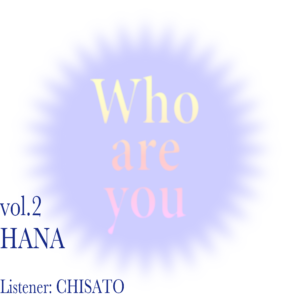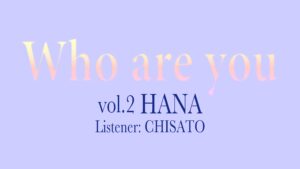Who are you / vol.2 HANA -ENver
Who are you / vol.2 HANA –ENver

”Who are you” is a content to get to know, look at, and deepen your understanding of a person.
Continuing from the first issue, this time the members interviewed each other, with CHISATO asking HANA a variety of questions.
HANA
Her eyes are always focused on everyday life and the society that is connected to it. She has been exposed to art since she was a child, attending art museums. And after an encounter with the iconography of Western painting, she was awakened to the fascination and depth of art and decided that she wanted to study and work in the field of art. Now a university student and having accumulated a wide range of experience in the field of art, she believes in the rich potential of art and is exploring the role that art can play in society, which she feels is “something strange. Even if she wants to talk about something big or do something about a problem in society, the first step is to start from everyday life. I was impressed by the way she focused on feminism and welfare issues as her own and those of others directly related to her, and took them one by one with sincerity. Her goal through the collective Channel is “to make people feel happy that culture and art exist through our activities. Channel also aims to be a place where people can find a place for their hearts and minds on the margins of society, and to create a place where “right answers” are not questioned. Through this interview, I felt this was possible with her.
BY CHISATO
*Interview with CHISATO from HANA*
▷Tell us how and why you decided to enter the cultural arts field!
Originally, my parents liked art museums, so we used to go there a lot. When I was little, I didn’t understand or was bored when they took me there. I became most aware of art when I learned about Western Renaissance art in my art class in the second year of junior high school. The class taught us that religious paintings of Western art of the time were filled with meaning, and that everything written on them had a meaning and conveyed a message to the viewer. I thought it was very interesting to know that they were not only beautiful but also had so much meaning. Many people find paintings and art to be boring, as if they are difficult or lofty, but they are really interesting because they are like solving a riddle, and each one has its own character, making them easy to relate to. I thought that if everyone knew about this, they would find it interesting.
▷How did you come to study in the field of fine arts?
When I was in junior high school, I came across the subject of iconography, and I knew that I could study it in the field of art history, so I decided that I wanted to study Western art history. At first, I narrowed down my choices to a school that focused on aesthetics within the philosophy department of a general university. But when I decided I wanted to study art more, I looked at art universities and found out that I could take the entrance exam on the basis of academic ability without any drawing skills, so I decided to enter an art university.
During interviews, I used to say, “I want to be a curator!”. I wanted to stand between the artist and the viewer and act as a bridge to convey the meaning of the paintings. I wanted to study for that purpose because I wanted to go down that road in the future, even if just a little.
▷What are you currently studying?
I am studying curation, management, and research. When the advertising design professor came, I learned about how to make announcements, catch copy, etc. I am also active in the field of project management. We also have a teacher who is active in the field of project management, and while learning theory, we also go to visit art festivals to see the sites and learn more about the case studies and mechanisms.
I also studied basic sculpture in a sculpture class during my first year. The idea was that this would help me understand how artworks are made, which would be useful for me when I get involved in the art world as an intermediary in the future. But when I actually did it, I found it extremely difficult. I had to look at things from multiple perspectives, and I couldn’t do what I wanted at all. Last summer, we all worked together in the heat of the summer for the Echigo-Tsumari Art Triennial, which is held every year in the sculpture course I am a member of. It took a lot more time and effort than I had expected. But I am glad that we did it, because I can now better imagine the artist’s feelings, I want to treat the work with care, and I want to understand the work better.
▷Tell us about the art field you are involved in now!
Overall, most of what I do is management and coordination. I manage and coordinate exhibitions of artists in the Photography Department at Nichi-gei, and I also assist people who are actually doing management work. I have also recently been allowed to participate in an art festival called Sense Island on Sarushima Island, where I assist the participating artists of TPR (TOKYO PHOTOGRAPHIC RESEARCH) with installation and other tasks.
▷What impact do you think the characteristics of art and art can have on society?
I feel a sense of constraint in society, and there are many times when I feel impatient and frustrated about whether or not I am doing the right thing. However, when I am allowed to be involved in art in this way, I am often amazed when I encounter good works of art. So I think that if everyone could experience this more, there would be time to take a break from the daily grind, and a kind of mental space would be created little by little. I hope that this will become more prevalent in society, because it definitely has such a role to play.
▷Among the events happening in society today, is there anything in particular that you are concerned about?
There are many things that I think are strange. But I think I often feel it from things that are close to me.
At the convenience store where I used to work, there was a single mother who worked from morning till night. She went to bed at 3 a.m. and worked with me from 6 a.m. I also used to see people like home helpers who would come to the house when my grandparents were still alive, and they were paid very little for a job that was absolutely necessary. I think those people who are living hard should be able to live a normal life. That is why I think that my involvement with the single mother was the catalyst for my interest in feminism. I also wondered what politicians were doing and what their policies were, and I became more interested in politics and started going to elections.
▷What artists and works have influenced you?
Scripcariu Ochiai Anna. You have origins in Japan and Romania, and the fact that you don’t know where your hometown is is the starting point for your work. It was easy for me to understand that my birth and my identity are directly connected to my personality, and from there I began to look at the works of half-Japanese and others. Then I found that many of them dealt with borders and their own birth. I guess I like the comparison of how they use it there and the works they created.
▷What do you value in your daily life?
In my daily life, there are many rough points in the world, like when I go to school or work and the train is crowded and I get pushed around and it makes me feel very rough, but if I were to get upset about every single one of them, I would be with them.
▷What do you hope to achieve through the collective?
I’d be happy if as many people as possible feel lucky to have art and culture through our activities!


